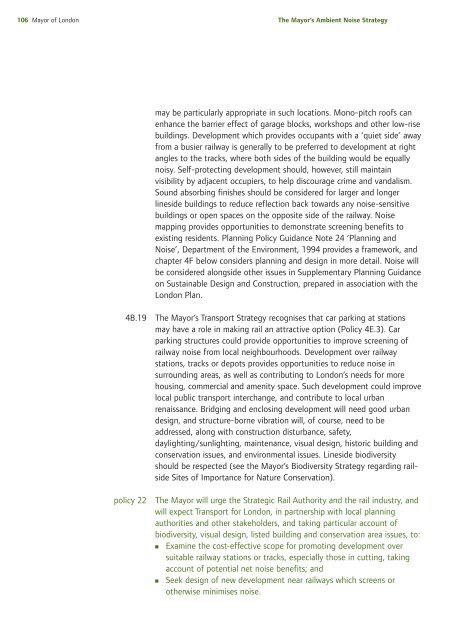The Mayor's Ambient Noise Strategy - Greater London Authority
The Mayor's Ambient Noise Strategy - Greater London Authority
The Mayor's Ambient Noise Strategy - Greater London Authority
Create successful ePaper yourself
Turn your PDF publications into a flip-book with our unique Google optimized e-Paper software.
106 Mayor of <strong>London</strong><br />
<strong>The</strong> Mayor’s <strong>Ambient</strong> <strong>Noise</strong> <strong>Strategy</strong><br />
may be particularly appropriate in such locations. Mono-pitch roofs can<br />
enhance the barrier effect of garage blocks, workshops and other low-rise<br />
buildings. Development which provides occupants with a ‘quiet side’ away<br />
from a busier railway is generally to be preferred to development at right<br />
angles to the tracks, where both sides of the building would be equally<br />
noisy. Self-protecting development should, however, still maintain<br />
visibility by adjacent occupiers, to help discourage crime and vandalism.<br />
Sound absorbing finishes should be considered for larger and longer<br />
lineside buildings to reduce reflection back towards any noise-sensitive<br />
buildings or open spaces on the opposite side of the railway. <strong>Noise</strong><br />
mapping provides opportunities to demonstrate screening benefits to<br />
existing residents. Planning Policy Guidance Note 24 ‘Planning and<br />
<strong>Noise</strong>’, Department of the Environment, 1994 provides a framework, and<br />
chapter 4F below considers planning and design in more detail. <strong>Noise</strong> will<br />
be considered alongside other issues in Supplementary Planning Guidance<br />
on Sustainable Design and Construction, prepared in association with the<br />
<strong>London</strong> Plan.<br />
4B.19 <strong>The</strong> Mayor’s Transport <strong>Strategy</strong> recognises that car parking at stations<br />
may have a role in making rail an attractive option (Policy 4E.3). Car<br />
parking structures could provide opportunities to improve screening of<br />
railway noise from local neighbourhoods. Development over railway<br />
stations, tracks or depots provides opportunities to reduce noise in<br />
surrounding areas, as well as contributing to <strong>London</strong>’s needs for more<br />
housing, commercial and amenity space. Such development could improve<br />
local public transport interchange, and contribute to local urban<br />
renaissance. Bridging and enclosing development will need good urban<br />
design, and structure-borne vibration will, of course, need to be<br />
addressed, along with construction disturbance, safety,<br />
daylighting/sunlighting, maintenance, visual design, historic building and<br />
conservation issues, and environmental issues. Lineside biodiversity<br />
should be respected (see the Mayor’s Biodiversity <strong>Strategy</strong> regarding railside<br />
Sites of Importance for Nature Conservation).<br />
policy 22<br />
<strong>The</strong> Mayor will urge the Strategic Rail <strong>Authority</strong> and the rail industry, and<br />
will expect Transport for <strong>London</strong>, in partnership with local planning<br />
authorities and other stakeholders, and taking particular account of<br />
biodiversity, visual design, listed building and conservation area issues, to:<br />
■ Examine the cost-effective scope for promoting development over<br />
suitable railway stations or tracks, especially those in cutting, taking<br />
account of potential net noise benefits; and<br />
■ Seek design of new development near railways which screens or<br />
otherwise minimises noise.
















